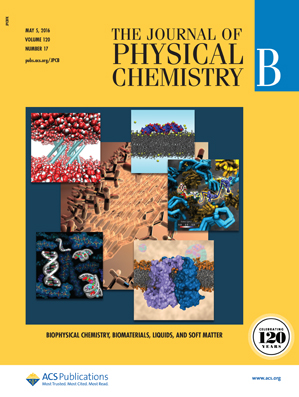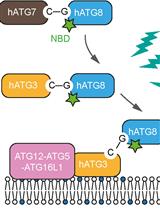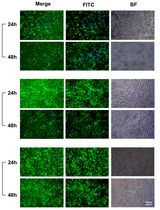- EN - English
- CN - 中文
Determining Efficiency and Selectivity of Lipid Extraction by Perturbing Agents from Model Membranes
采用源自模型膜的扰动剂测定脂质提取的效率和选择性
发布: 2016年11月20日第6卷第22期 DOI: 10.21769/BioProtoc.2016 浏览次数: 7617
评审: Marc-Antoine SaniVenkatasalam ShanmugabalajiDaniel Kraus
Abstract
Several membrane-perturbing agents extract lipids from membranes and, in some cases, this lipid efflux is lipid specific. In order to gain a better description of this phenomenon and to detail the intermolecular interactions that are involved, a method has been developed to characterize the extent and the specificity of membrane-lipid extraction by perturbing agents. A perturbing agent is incubated with model membranes existing as multilamellar vesicles (MLVs) and subsequently, the remaining MLVs and the small lipid/perturbing agent complexes resulting from the extraction are isolated and analysed to assess the extent and the specificity of the lipid extraction.
Background
Several membrane-perturbing agents extract lipids from membranes; these include proteins, peptides, and detergents. Several of these lipid extractions are fundamental processes in biology. In some cases, the process is lethal; this is the case for some antibacterials that extract lipids from bacterial membranes leading to the death of the cells (Bechinger, 2014; Schaefer et al., 2014). In other systems, this process is vital. For example, ApoA1 is a protein that binds to cells and extracts phospholipids and cholesterol to form nascent high density lipoproteins (HDL), a process critical for the reverse cholesterol transport and therefore playing a pivotal role in the control of atherosclerosis (Strömstedt et al., 2010). It has been shown that some of these lipid extractions are lipid specific; in other words, the lipid composition of the extracted fraction is different than that of the original membranes. It is expected that such specificity will be reported more often considering the recent progress of lipidomics. In general, the lipid specificity of the induced lipid efflux is poorly characterized despite the pivotal role it plays in biological processes. We have recently shown that selective lipid efflux depends on specific interactions with membranes (Therrien et al., 2013; 2016). In order to gain a better description of this emerging phenomenon and to detail the intermolecular interactions that are involved, a method has been developed to characterize the extent and the specificity of membrane-lipid extraction by perturbing agents using model membranes. A perturbing agent is incubated with model membranes existing as multilamellar vesicles (MLVs). The classes of perturbing agents include proteins (e.g., binder-of-sperm proteins BSPA1, ApoA1), peptides (e.g., melittin, antibacterial peptides), and detergents (e.g., Triton X-100). The use of model membranes allows a complete control of the lipid composition, modulating in a precise manner molecular features such as the charge and the H-bond capacity, and defining how these factors contribute to the lipid specificity of the extraction. Subsequently, the remaining MLVs, which may include some perturbing agent, are separated by centrifugation from the small lipid/perturbing agent complexes resulting from the lipid extraction. The lipid compositions of the pellet (representative of intact membranes) and of the supernatant (representative of the lipid efflux) are analysed in order to assess the extent and the specificity of the lipid extraction.
Materials and Reagents
- Progene® 1.5-ml microcentrifuge tubes
- V-Vial screw-thread sample vials, 5 ml, with PTFE-lined caps
- Pyrex Brand 9800 test tubes, 20 ml
- Syringe
- Glass test tube
- Marbles
- YMC diol column
- Lipids (high purity) (Avanti Polar Lipids) (ex. 1-palmitoyl-2-oleoyl-sn-glycero-phosphocholine [POPC]; 1-palmitoyl-2-oleoyl-sn-glycero-phosphoethanolamine [POPE])
- Membrane perturbing agent of interest
- Benzene (ACS grade)
- Methanol (HPLC grade)
- Milli-Q water
- 3-[N-morpholino]propanesulfonic acid (MOPS) (> 95%)
- Sodium chloride (NaCl, high-purity grade)
- Ethylenediamine tetraacetic acid (EDTA) (99.4-100.6%)
- Potassium phosphate, monobasic (KH2PO4) (dried at 105 °C under vacuum for at least 4 h prior to its use to ensure it is dry)
- Concentrated sulphuric acid (H2SO4) (ACS reagent, 95.0-98.0%)
- Peroxide (H2O2) (30%) (ACS reagent)
- Sodium metabisulfite (Na2S2O5) (ACS reagent, >97%)
- Ammonium molybdate tetrahydrate [(NH4)6Mo7O24·4H2O] (ACS reagent, 81.0-83.0%)
- Ascorbic acid (99%)
- Acetonitrile (HPLC grade)
- Ammonium acetate (CH3CO2NH4) (≥ 98%)
- Nitrogen
Equipment
- Microcentrifuge (Eppendorf, model: 5417 R ) equipped with a rotor (Eppendorf, model: f45-30-11 )
- UV-Vis spectrometer (Agilent Technologies, model: Cary 6000i )
- LC/MS system (Agilent Technologies, model: 1100 series system ) with a 1100 MSD mass spectrometer (Agilent Technologies, model: 1100 MSD )
- Water bath
Procedure
文章信息
版权信息
© 2016 The Authors; exclusive licensee Bio-protocol LLC.
如何引用
Lafleur, M. and Therrien, A. (2016). Determining Efficiency and Selectivity of Lipid Extraction by Perturbing Agents from Model Membranes. Bio-protocol 6(22): e2016. DOI: 10.21769/BioProtoc.2016.
分类
生物化学 > 脂质 > 脂质分离
生物化学 > 脂质 > 脂质-蛋白互作
您对这篇实验方法有问题吗?
在此处发布您的问题,我们将邀请本文作者来回答。同时,我们会将您的问题发布到Bio-protocol Exchange,以便寻求社区成员的帮助。
提问指南
+ 问题描述
写下详细的问题描述,包括所有有助于他人回答您问题的信息(例如实验过程、条件和相关图像等)。
Share
Bluesky
X
Copy link














